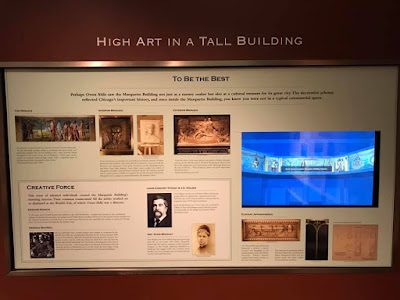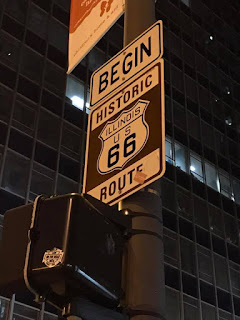23 May 2019
Headed to a meeting at Year Up Chicago at 223 West Jackson Boulevard.
While on my way to lunch, checked out the Chicago City Markets at Daley Plaza.
Meanwhile, on other side...
The MacArthur Foundation Exhibition:
Walked over to the start of the historic Route 66.
Headed to a meeting at Year Up Chicago at 223 West Jackson Boulevard.
Saw the Chicago Board of Trade Building en route to the meeting
I was hosted by Student Ambassadors Edward Sandoval and Ana Munoz for a tour of the premise.
Year Up Chicago runs a one-year, intensive training programme for youths aged 18 to 24 years old. The training programme imparts technical skills; professional skills such as networking and other soft skills; as well as internship with established organisations. Coaches conduct weekly reflection exercises with students and actively seek their feedback to enhance the programme.
Year Up Chicago also provides wraparound services for its students who might be facing hardships. The programme also provides college credits, should students wished to continue pursuing their studies in college.
I also asked Edward and Ana on the challenges that youths like themselves face, as well as the challenges faced by low-income families.
With Edward Sandoval and Ana Munoz, Year Up Student Ambassadors
Returned back to Metropolitan Family Services office. As this was the second last day, I walked around and got hold with colleagues who would not be present the next day.
Photo with Vaughn Bryant, Director, Communities Partnering 4 Peace (CP4P), who brought me around on my very first day with Metropolitan Family Services
Photo with Bryan Johnson, whose research report I read on my first day at Metropolitan Family Services and met on my second week there to patiently explain all the acronyms and programmes
While on my way to lunch, checked out the Chicago City Markets at Daley Plaza.
Chicago City Markets at Daley Plaza
Filipino cuisine
Lunched at Revival Food Hall
Revival Food Hall was a battleground. With 20 minutes for lunch, I hurriedly settled for the shortest queue line and found myself seated with Andrea, an anti money laundering expert, who shared briefly about money laundering and her work.
I then headed to Metropolitan Family Services Learning and Wellness Center, which I visited in early May, to meet Glenn Willoughby to learn from his perspectives as a beneficiary to Metropolitan Family Services programmes.
Glenn is happily married with three children, all of whom are enrolled with the Learning and Wellness Center. He first came to know about the childcare services provided by Metropolitan Family Services through his brother who had also enrolled his son with the Center. Glenn volunteers actively with the Center, reading books to students and helping to clean up.
Besides volunteering at Metropolitan Family Services, Glenn organises book fairs and distributes books for free to children. He also runs a Englewood Art Collection, to provide an outlet for youths to express themselves.
I asked him about his experience living in a precarious neighbourhood, especially as a parent to young children. Glenn shared that he used to live in Brownsville, where rental could work out to be USD 1,800 a month; as compared to USD 750 a month in Englewood, the community he is now at. He plans to use his savings to one day purchase his own property.
Glenn and his wife are the only married couple in the block. He shared that it was important to be street-smart and conduct yourself appropriately. If you show respect to gang members, they would reciprocate that respect. However, he would not bring his children to play at the playground in the neighbourhood.
On segregation and gentrification, Glenn shared with me about this cool Folded Map Project, which used photography to contrast the living environment of the North and South of Chicago City. He invited me to his community a decade later to see for myself how the community would transform, with developments bringing in services, which would result in higher property taxes and pushing residents who could not afford out to the suburbs. Many would end up having their properties put up on sale as dollar houses, which would be grabbed by property developers to hold on to and transact at a higher price later on.
I probed about the relationship between the community and police. Glenn shared that the struggle within the community is very real. There was resentment to police within the African American community and a constant fear of being pulled over by Police. Police officers could cite that they "smelled weed" or say "I feel threatened" and make an arrest, both of which would be difficult to prove otherwise in court.
I enquired about his family history. Glenn shared that in the 1980s, the use of crack and cocaine skyrocketed as they were new and cool. There was a lack of awareness of their harmful effects, and many households were destroyed, including his parents. A Christian Youth Center situated in a neighbouring White neighbourhood decided to cross over to the black neighbourhood he was living in to reach out and recruit youths. That was when he mixed with other White youths, went for trips and began to see the world as a larger neighbourhood. He saw the commonality between him and other White youths (they were poor and they had to do homework), and that they were not much different. The White neighbourhood was resistant to the church's engagement with black youths, so a van had to send them back home at night for safety reasons. He attributed his ability to dream big, due to his widened exposure.
Glenn started off washing cars and worked hard, taking the chance to learn by asking questions. When there was a vacancy in the Service Consultant role, he applied for it and got it because he had been learning about the job role. That saw a massive jump in his earnings until he was laid off.
Besides doing freelance photography, Glenn is also pursuing his studies in early childhood, sparked by the fact that there is a lack of black male teachers in the pre-school sector.
Glenn shared that children from disadvantaged background are trying to survive, and it would be difficult for them to dream. They don't know that "I'm worth better", as they had never seen people who had lived in their full potential. Thus, it was important to instill self-confidence in them to let them want to achieve more.
During the 2-3 hours long conversation, I could not help but reflect the fact that we were of about the same age, but the experiences that we had to grow up with were so drastically different. There were moments where I got emotional, and I remembered telling Glenn that he should explore a career in motivational speaking.
With Glenn Willoughby, who gladly agreed for me to share the contents of our conversation
Glenn gave me a lift to the nearest subway station. During the drive, I shared that I had walked from the train station and almost reached the Learning and Wellness Center before being asked to get into the car by Cristy. He concurred that the weather back then was still chilly. He would not advised doing it during a warm weather day like today. Sadly, gun violence incidents go up as the temperature goes up.
And this is Iron Man
And then I realised I missed my stop and reached the terminal...
Back to office to sort out my gift stash for colleagues
Chicago City Markets gave way to a protest at Daley Plaza. It was another protest, in the week, to save reproductive rights.
The clothe hanger was used as a tool for illegal abortion in the past
The police presence was significantly higher than the past protests/rally I attended. Turned out it was because there was a counter-protest by the Pro-Life Action League a distance away.
Protesters holding a banner facing the pro-life camp
The counter protest by pro-life activists, who were drumming and cheering away
Meanwhile, on other side...
Savouring Ramen at Well Street Market, the first dish I had on the first day in Chicago
I checked out the Marquette Building at 140 South Dearborn Street, which had an exhibition on the history of the building and its contribution to Chicago architecture.
To follow those waters which will henceforth lead us into strange lands...
In vain, I showed the Calumet to explain that we had not come as enemies...
Passing two leaves up the river we resolved to winter there... being detained by my illness
The De Profundis was intoned... the body was then carried to the church
Mosaic art on the level 2 walls above the lobby:
Father Jacques Marquette S.J., a French Jesuit missionary, who discovered the Chicago River
The Chicago Blackhawks of the National Hockey League was named after Black Hawk, who fought on the side of the British against the US
René-Robert Cavelier, Sieur de La Salle, a French explorer and fur trader in North America.
Chief Joseph War Eagle, a World Light Heavyweight Wrestling Champion for 7 years.
The MacArthur Foundation Exhibition:
The Marquette Building was built in 1895
Aldis' theory on creating a profitable skyscraper:
1) Office that gives up the most for light and air is the best investment;
2) Second-class space costs as much to build and operate as first-class space. Therefore, build no second-class space;
3) The parts every person entering see must make a lasting impression. Entrance, first floor lobby, elevator cabs, elevator service, public corridors, toilet rooms must be very good;
4) Generally, office space should be about 24 feet deep from good light;
5) Operating expenses must be constantly borne in mind. Use proper materials and details to simplify the work;
6) Carefully consider and provide for changes in location of corridor doors, partitions, light, plumbing and telephones;
7) Arrange typical layout for intensive use. A large number of small tenants is more desirable than large space for large tenants
8) Upkeep of an office is most important. Janitor service must be of high quality, elevator operators of good personality. Management progressive.
Walked over to the start of the historic Route 66.
Ending the evening with an ice cream








































































































No comments:
Post a Comment
Please share your feedback and comments.